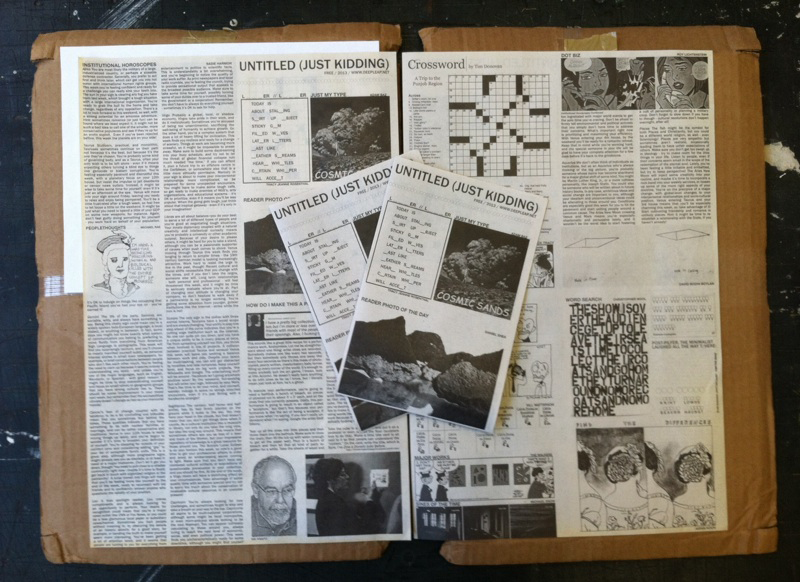I am watching “Do Voices,” the last piece in Untitled (Just Kidding), a collection of short video works by artist Jesse Malmed. During the video’s final minutes, singing voices chime in at various points around me. To my left I hear a scratchy Irish accent, and behind me to my right I can discern a timid woman’s voice. Malmed, the star of the evening, is present, both orchestrating the voices and singing with them.
The scattered chorus is made up of five people in the screening room, singing along with the text on screen. The work concerns navigating cultural differences and cross-cultural participation. As the song progresses, all five in unison sing the lyrics “We sing alone,” followed by one individual singing “We sing together.” Eventually, they all do sing together, and “Do Voices” comes to an end.
Jesse Malmed, thirty-one, explains that his background is in performance-based art, and he now strives “to bring a sense of liveness to a cinematic space”—especially in “Do Voices.”
The video also shows clips of Robin Williams, an actor Malmed admires. Williams flashes across the screen in segments from his stand-up comedy routines, and as Mrs. Doubtfire explaining—and demonstrating—that his special talent is that he can “do voices.” “What he did is so responsive to people, to the energy in the room,” Malmed says. He hopes to achieve a similar sense of dynamism, and so chose to end Untitled (Just Kidding) with a theatrical performance that “activates the cinema.”
Housed at the Reva and David Logan Center, the exhibition is co-presented by the Hyde Park Arts Center’s Ground Floor, a program that brings together artists from Chicago universities. Now in its third year, Ground Floor has this year recruited twenty artists from university classes of 2013 and 2014. Malmed, a 2014 graduate of the University of Illinois at Chicago’s Moving Image Program, will also perform at HPAC on February 18.
With about fifty people in attendance, Malmed showed seven works ranging from three to eighteen minutes long. Many feel particularly like responses to Internet culture; monumental emoticons cycle on the screen as a candy-colored patchwork background slides by. Spliced into the clips of Robin Williams are scores of imitations from fans on YouTube. The mood is often light and musical, and the videos invoke the staccato of Internet browsing, veering from subject to subject. Both “Happy Days” and a Tupac track find their place.
Aside from “Do Voices”, the work that stands out the most is “IN3DIA,” from 2007, the only video in the program that was not made in the last two and a half years. Meant to embody the memory of travel, “IN3DIA” is a silent work that consists of 1,200 photos Malmed shot when he was in India. They flash across the screen in alternating colors of cyan and red, reminiscent of the old-fashioned way of creating a 3-D image.
Since “IN3DIA,” Malmed has prefered to make more complex pieces addressing multiple themes. Humor is an important element. One woman told him she felt numerous times in the evening that she was privy to an inside joke.
Malmed responded that humor is something he consciously inserts into his videos, but not in an effort to provoke laugh-out-loud responses. Although there were a few chuckles throughout the performance, Malmed searches for ways “to instrumentalize jokes in a way that does not effect responses of humor as laughter.” He explains, “There’s something kind of satisfying of thinking that something is funny without the bodily response.”
While he doesn’t oppose laughter, Malmed’s approach to humor is tied to his use of not-quite-3-D effects; he seeks to transmit an awareness of the response-eliciting mechanism rather than the response itself.
While Malmed stresses the importance of the performance-based aspects of his work, only two of the seven pieces contained live performance. One of these consisted only of Malmed shining a flashlight on the screen and the nearby walls for thirty seconds. At the beginning of “Do Voices,” he brought a chair to the front of the screen and stood with his back to the audience, making wildly exaggerated flourishes with his arms and hands as a choral piece played in the background. In a room of mixed emotions, from furrowed brows to half-smiles, it seemed that Malmed, a cheeky “self-trained conductor,” achieved his goal of bringing cinema to life.

